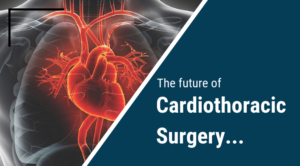CARDIOTHORACIC SURGERY
 Cardiothoracic surgery is a specialised surgical branch in which the cardiovascular surgeon performs cardiovascular (heart and blood vessel) surgery and pulmonary (lung) surgery. These surgeries are performed to treat diseases of the heart, lungs, and other structures, such as the trachea (windpipe), oesophagus (feeding tube), and diaphragm.
Cardiothoracic surgery is a specialised surgical branch in which the cardiovascular surgeon performs cardiovascular (heart and blood vessel) surgery and pulmonary (lung) surgery. These surgeries are performed to treat diseases of the heart, lungs, and other structures, such as the trachea (windpipe), oesophagus (feeding tube), and diaphragm.
Open heart surgeries treat multiple and complex blockages in the coronary arteries, complex or larger holes in the heart can be closed, major heart valves repair or replacement and procedures to restore heart rhythm problems (Maze procedure) are performed.
Coronary artery bypass grafting (CABG): when complex or multiple coronary blockages are present, this surgery is advised. CABG redirects blood around a section of a blocked or a partially blocked artery to improve blood flow to the heart muscle. The procedure involves taking a healthy blood vessel from the leg, arm or chest and connecting it beyond the blocked arteries. This can be done both by Open heart and minimally invasive methods.
- Heart valve repair or replacement:Heart valves regulate the flow of blood inside the heart. When the valves do not work properly, this causes extra strain on the heart and leads to heart failure. Open heart surgery to repair or replace the valve is then offered.
- Carotid endarterctomy: This is a surgery that removes plaques in the carotid arteries (arteries in the neck that supply blood to the brain).
Ventricular restoration and aneurysmectomy: Left ventricular dilatation and aneurysm can worsen hemodynamics in heart failure patients. These surgeries help to restore the normal chamber dimensions and improve quality of life.
Mechanical circulatory assist device: This is a device which assists cardiac circulation and can be used to either completely or partially replace the function of a failing heart. They are designed to assist either the right ventricle (RVAD) or the left ventricle (LVAD), or to assist both ventricles (BiVAD). The long-term VAD can be used as a bridge to transplant as well as destination therapy for patients who are not candidates for heart transplant.
Heart transplant: Heart transplant is recommended for patients with progressive end stage heart failure who are not benefitting from medical and device therapy. During a transplant procedure, the surgeon connects the patient to a heart-lung machine, which takes over the functions of the heart and lungs. The surgeon then removes the diseased heart and replaces it with the donor heart. Finally, the major blood vessels are reconnected, and the new heart is ready to work.